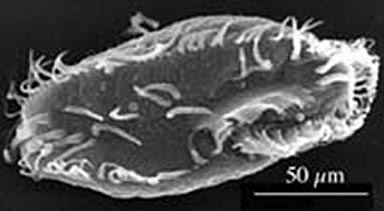Research
My research primarily concerns the biology of a group of unicellular eukaryotes, ciliates (eg. Paramecium), which uniquely possess two types of nuclei in a single cell. Human, for example, contains only one nucleus in each cell, and this nucleus functions as the genetic material reservoir and also guides cellular activities. In ciliates I work with these two functions are separated into two types of nuclei (germline vs. somatic). The interlink between the two nuclei is largely unknown and my research aims to address some phenomenon derived from this peculiar nuclear duality. (Pix: Oxytricha Trifallax, http://www.biology.utah.edu/posters2.php?id=23)
I. Evolution and functions of transposons
Transposable elements, or transposons, are selfish DNA elements that "jump" from one position to another one on host genomes. When a transposon transposes to where an essential gene locates, this process may kill the host by altering the gene expression. In contrast, transposons could drive the process of speciation and play an important role in evolution. Almost all known organisms were infected by transposons through evolutionary time. In addition, transposons, like most other organisms, are also highly diversified, and transposons found in bacteria may be so different from those found in human.
The first research project carried out in my lab is to study the evolutionary history of a transposon family, the TBE family, which was thought to be present only in a few late diverged ciliate species. Our data, however, suggest that the TBE transposon family is present in many other ciliate species. We speculate that TBE related sequences are more widely distributed than previously thought and may be present in one or more major ciliate lineages. Moreover, since transposons are "DNA parasites", it is also interesting to examine how TBE transposons evolve with their hosts and whether TBE's evolutionary history agrees with their host's one. Dr. Wilhelm Foissner from Austria, Dr. Laura Landweber from Princeton University, and other ciliate collectors are collaborating on this project with us. Hamilton undergraduates Z. Li (08'), T. Coppola (10') and A. Lee (11') have also made significant contributions to this project. The second project related to TBE transposons is the structural formation of the TBE elements. Most transposons, while highly diversified, contain only one single gene. The TBE transposons contain at least four different genes. Where and when did these additional genes move into TBE? How did it happen? Do these extra-genes help increase the fitness of transposons? By tracing the formation of complex transposons we are hoping to address the above questions and gain insights on how complex transposons were formed and the adaptation that transposons made to survive in their host environments. T. Coppola (10') is actively involved in this project.
II. Chromosome and gene regulation
Another interesting feature associated with Oxytricha trifallax is fragmented and multiploid somatic chromosomes. Genes in most high eukaryotes, such as human, are normally present in a single copy per haploid genome and a chromosome may contain thousands of genes. Some ciliates, such as O. trifallax, fragment their chromosomes to a degree that one mini-chromosome would contain only one gene. Furthermore, the gene-sized chromosomes are present in multiple copies in each cell.
The first question that we attempt to address is whether different genes/gene chromosomes are present in different copy numbers. Although it was speculated that gene chromosomes are present in different copy numbers, there was no conclusive datum backing up this theory. T. Lu (11') and I worked together last year and have made significant progress on this project. Dr. Hans Lipps from University of Witten, Germany, is collaborating with us on this project.
III. Gene organization on germline DNA
Despite interesting features coming with the heavily fragmented somatic chromosomes, gene organization on germline chromosomes, which later give rise to somatic chromosomes, is largely unknown. How much DNA is eliminated during the conversion of germline DNA to somatic DNA? Would genes involved in similar biochemical processes locate closely on germline DNA? How do transposons distribute throughout the germline DNA? These are only a subset of questions that we are eager to learn from ciliates which possess nuclear duality. S. Sarker (11') and I have been working together since last summer to compare some germline sequences to their somatic counterparts in O. trifallax. We hope to identify more unorthodox gene arrangements and signals that may be involved in chromosomal fragmentation and amplification.
IV. Other collaborations

My lab is also collaborating with Lehman's group in reconstructing phylogenetic trees of several different signal transduction receptor genes. I am also collaborating with McCormick's and Garrett's labs to explore protist diversities in Green Lake (Jeffrey Corbett 10'). There is also a developing collaboration with visiting Professor Ashleigh Smythe to identify new genes to help reconstruct evolutionary history of nematodes.



